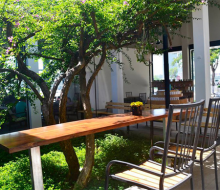Hoi An is an old town down the Thu Bon River, on the coastal plain of Quang Nam Province, about 30 km south of Da Nang City. Hoi An used to be known on the international market with many different names such as Lam Ap, Faifo, Hoai Pho and Hoi An.
(1).jpg)
What is so special about Hoi An is that this little port town is in an incredible state of preservation. It offers some of the most densely-concentrated sights in Viet Nam with its old streets bordered with ancient houses and assembly halls, its pagodas, temples, ancient wells and tombs. In total, more than a thousand places of interest. The architecture of Hoi An is characterised by a harmonious blend of Vietnamese, Chinese and Japanese influences. After many centuries, Hoi An is still respectful of its traditions, folk festivals, beliefs and of its sophisticated culinary art. Set in a quiet environment, Hoi An is surrounded by peaceful villages that have crafts such as carpentry, bronze making, ceramic...
.jpg)
Researchers said most of the buildings in Hoi An underwent restoration at the beginning of the 19th century, even if they might be constructed long time ago. The ancient architecture shown most clearly in the Ancient Town that located in Minh An Ward. It covers about 2 square kilometres and almost of all famous relics in Hoi An are gathered here. The streets are very short and narrow, having a winding, crossing as the chessboard style. The topography of the ancient town tilt gradually from north to south. The buildings in the old town is built mostly with traditional materials such as: brick, wood and no more than two floors. The traces of time is able to find not only on the architectural design of each building but also everywhere like: on the yin-yang roof tiles covered with moss and plants; the old gray mold walls; the pictures carved on a strange animal, or describing a old story… Having inherited a multi-cultural architecture so varied and sophisticated, Hoi An must have attracted numerous and talented workers in carpentry, ceramics, and woodcarving from China, Japan and other regions of Viet Nam.
.jpg)
For centuries, Hoi An had developed into a melting pot of various nationalities who came to the area, bringing along their own cultures. Accordingly, Hoi An features the co-existence of indigenous customs and habits and those imported by foreign settlers.
Tradition is still very much alive in the Old Town. Even though many of the old shops have been converted to modern businesses aimed at tourists including countless tailors, souvenir shops, art galleries, restaurants and cafés, all have been converted with care to preserve the past.
Happily, all Hoi An’s major attractions or landmarks are located within walking distance of each other including the Japanese covered bridge, the Chinese assembly halls, Guan Yin Temple, the museum of history and culture and the Tran family home and chapel.
It’s amazing to see such a huge variety of local cheap eats and fine dining in a tiny town like Hoi An. Diners can select from both local and western cuisines at most of the up-market restaurants.
.jpg)
Many of them feature big lounge bars on the ground floor and an eating section with a balcony upstairs. The highlights of the meal often include local specialties such as white rose (prawn dumplings) and cao lau (a pork noodle dish).
Nightlife in Hoi An’s Old Town is not extremely hectic and things usually get quiet after 22:00. Still, travellers can easily find a place or two to hang out and enjoy a few drinks, snacks or a game of pool and darts.
Many cafés and bars offer happy hours and some even start as early as 16:00. The idea of chilling out in a century-old shop-house on big and comfortable sofas and some dancing space in certain venues is appealing to many and Hoi An’s nightlife is certainly friendly.
Hoi An old town with colourful lanterns at nights, with old plain houses and special mysterious cultural elements, and with the etiquette & culturally hospitable and friendly people are warmly welcoming you.
Chia sẻ










